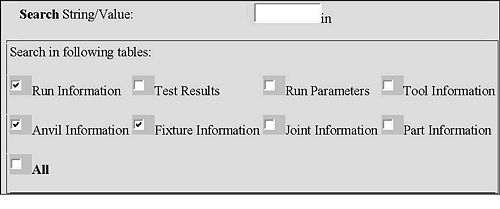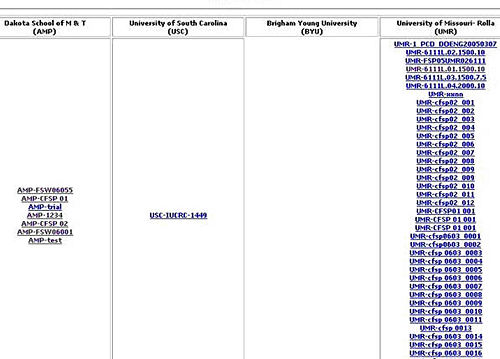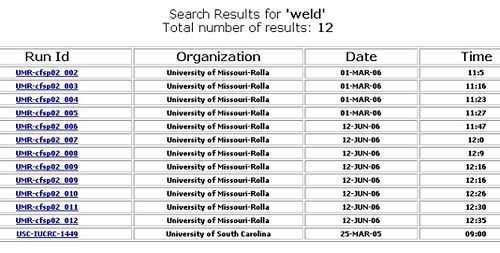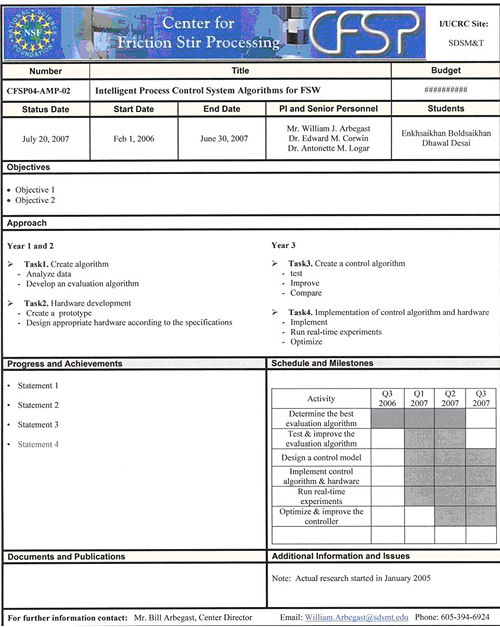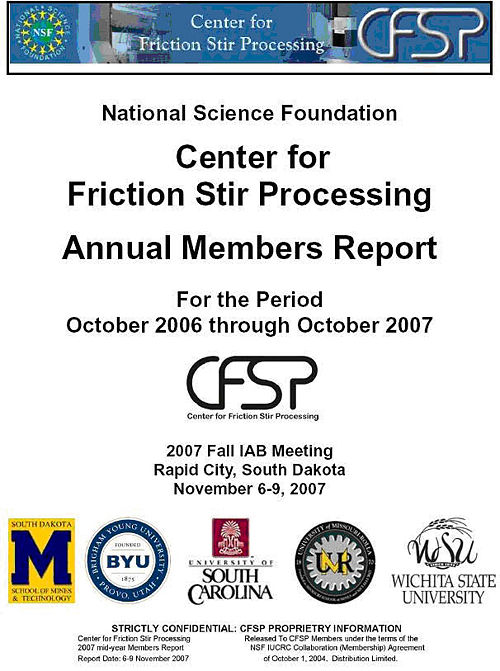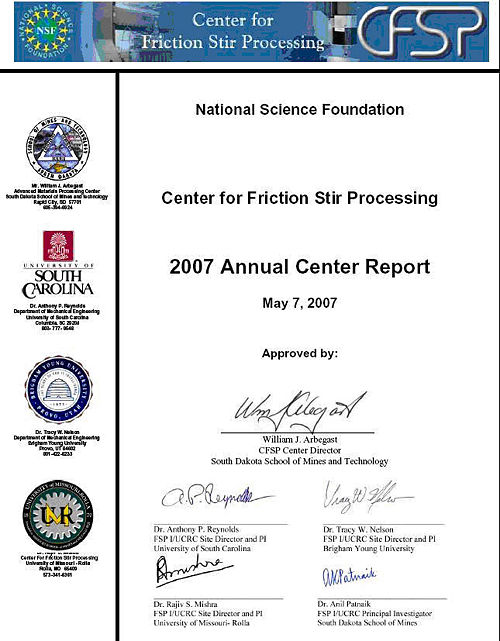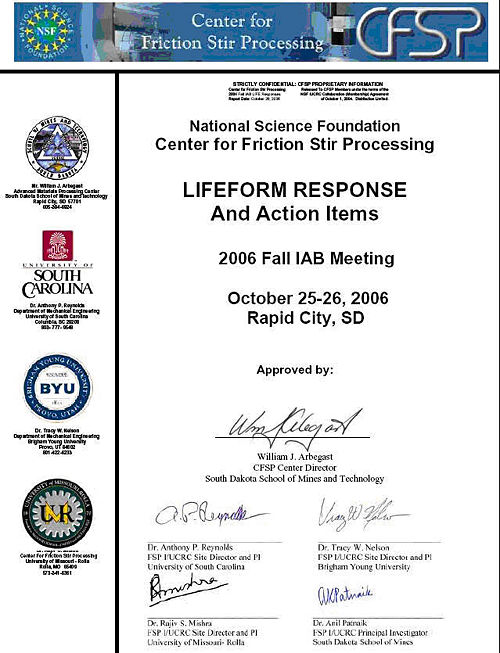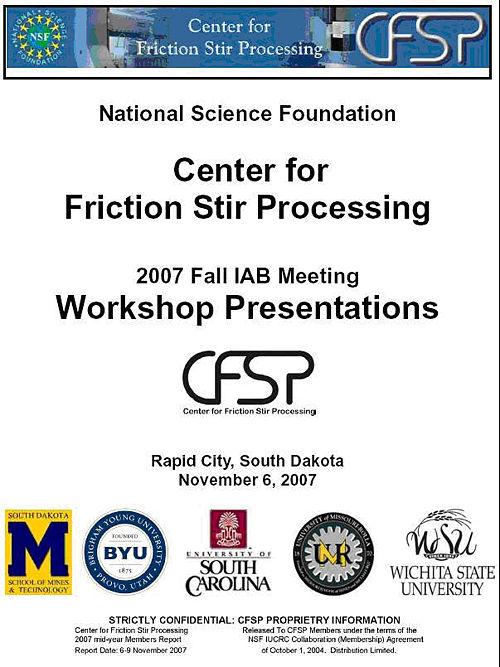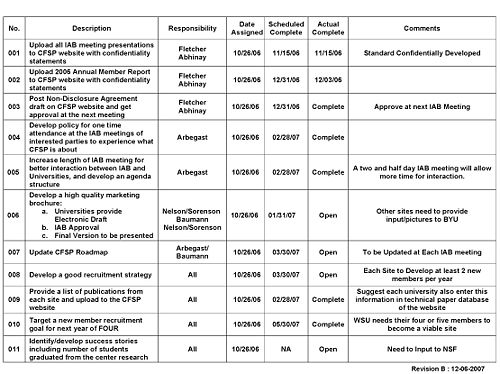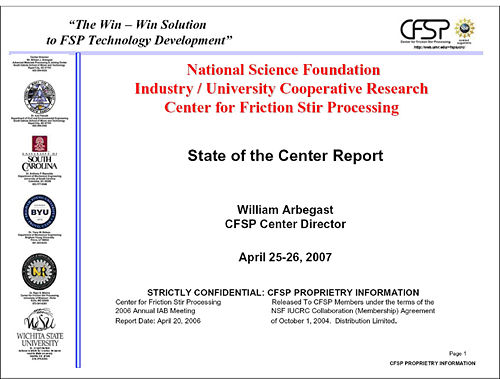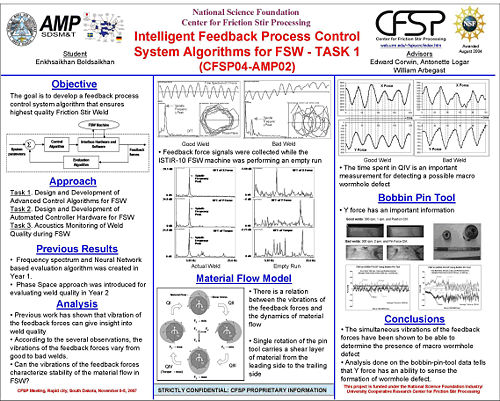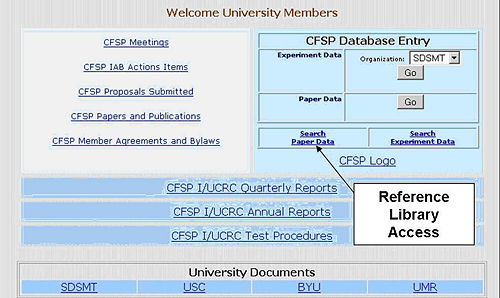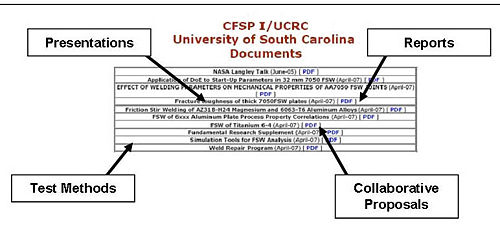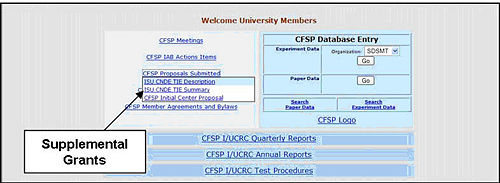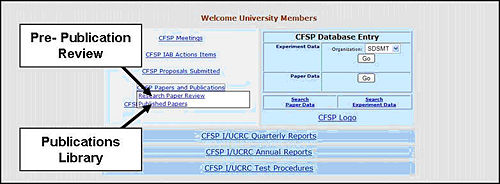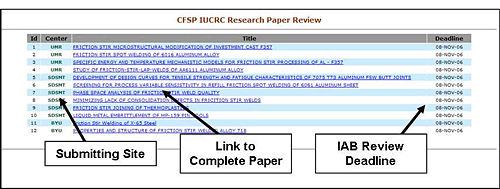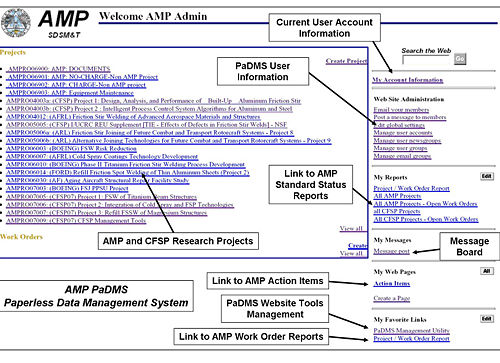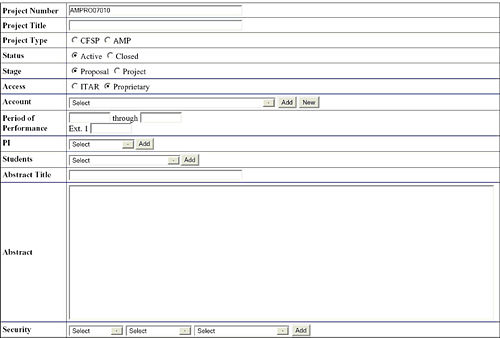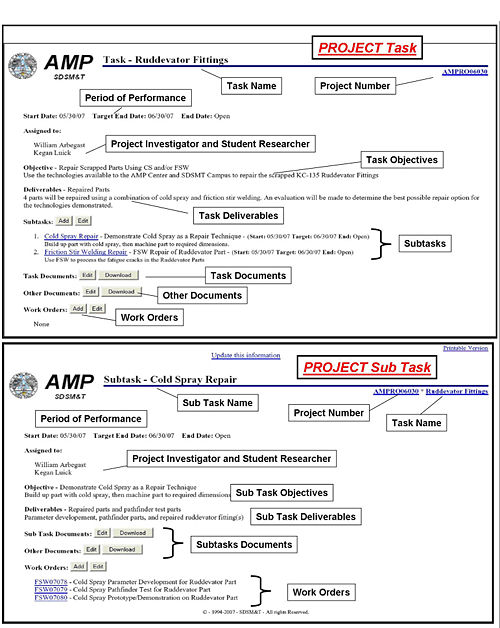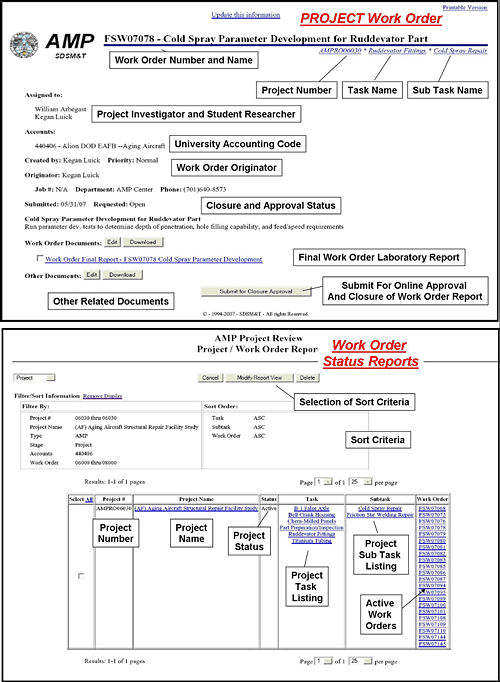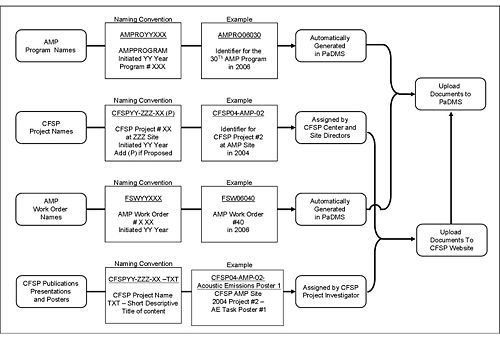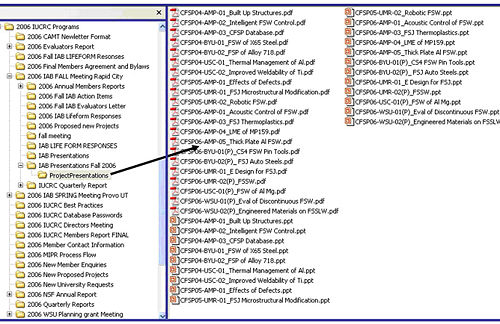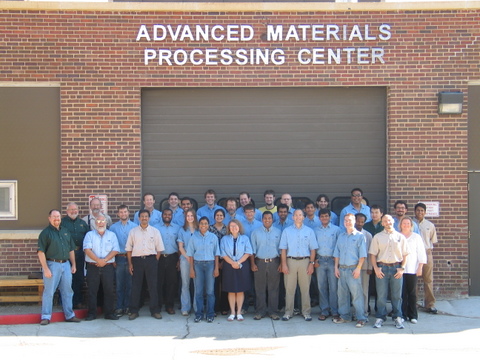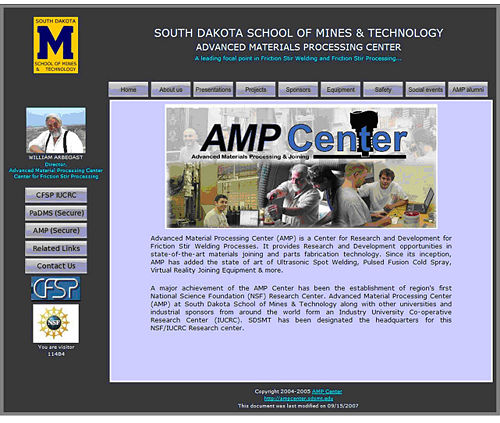Center Operations
From Center for Friction Stir Processing Guide
Center Operations
Each university site of the CFSP performs focused research in support of the specific needs of the IAB Members affiliated with that site, and, as approved by the entire IAB as a whole. In order to have an informed IAB knowledgeable to make these project selection decisions, and, to make meaningful adjustments to the long term Technology Development Roadmap (Section 2.1.2).
It is imperative that all IAB Members be made aware of all the research being conducted at each of the university sites. The CFSP policies, practices, and procedures (P3) are designed to maximize the communication between the faculty, staff, and student researchers at the university sites and the technical representatives of the IAB Membership.
Engaging active participation by the IAB Membership such that they take “ownership” of current research and proposed new research directions are critical to the center growth and member retention. For a multi-university I/UCRC such as the CFSP, Center Operations can be described as the business of communication of the status and health of the center, and, the status and direction of the research, to the IAB Membership. Budget and funding management, although reportable to NSF and the IAB, is generally performed using the existing university site procedures.
There is great flexibility in the use of local management tools to meet the documentation and reporting needs of the sites as requested by the university and IAB Membership affiliated with that site. However, reporting at the Center level requires standardization of documentation across the university sites. Standardization of documentation and reporting ensures all information has a common content and format for transmittal to the IAB. Several management tools have been designed and implemented at the CFSP to accomplish this.
Development of an Interactive Website
The web has become a communication tool of choice throughout industry. During the first year of the I/UCRC award (2004) the members of the CFSP IAB approved a multi-university proposal to develop a secured, interactive website for the CFSP. This website is designed to be the official communication tool between university sites and the IAB Membership. The CFSP website (http://cfsp.sdsmt.edu/) was developed by the Missouri University of Science and Technology and revised by SDSMT with funding provided by all CFSP sites.
To accomplish this, since MUST was not officially a member of the CFSP at this point, funding was transferred to the SDSMT by invoicing the BYU and USC sites and SDSMT awarded a subcontract to MUST to develop the website and database. For project tracking and reporting purposes, the Database and Website Development project was identified as a SDSMT Site project.
The public areas of the official CFSP website (http://cfsp.sdsmt.edu/) contain general information about the center as well as marketing information useful to prospective sponsors, including information on university members, sponsors, the mission of the center, and center news/announcements. In addition, each university has its own web presence describing activities specific to its local activities. Each university local web site links to the CFSP site, and the CFSP site links back to each local site. Likewise, links are created to the sponsors’ websites.
Users with access to the restricted portions of the site login as either industry or university members to access the following information:
- IAB Meeting Agenda and Presentations (Section 4)
- Action Items (Section 4)
- Proposals Being Submitted (Section 3.3.8)
- Papers And Publications (Section 2 and Section 3.4)
- Member Agreements And Bylaws (Section 2)
- Project Quarterly Reports Section 3.3)
- Annual Members and NSF Reports (Section 4)
- LIFE Form Reports (Section 4.2.2)
- CFSP Database Access (Section 3.2 and Section 3.3)
- Supplemental University Documents (Section 3.3)
- Center Test Procedures
The web site provides a mechanism for sharing agreed upon standards for testing and for document preparation. For example, the link labeled “CFSP I/UCRC Standard Test Procedures” provides links to agreed upon standards for conducting special experiments such as the “cut compliance residual stress procedure” developed by the USC CFSP Site. That file provides detailed instructions on how to prepare the sample for welding, how to clamp the sample, how to acquire data during the weld, and includes a MathCAD worksheet for computing the residual stress profile for the data gathered.
Publishing the procedures and examples of how the procedures are applied aids new students and faculty researchers in understanding the management methods of the CFSP and improves the standardization and quality of the data generated across all participating university sites. Oftentimes, these special test methods can be implemented within the IAB Members’ organizations.
The CFSP web site provides a vital communication link between the site universities and between universities and the sponsors. The four main functions of the web site can be summarized as:
- Marketing Information for Non-Center Members (External)
- CFSP Document Management (Internal)
- CFSP Experimental Data Management (Internal)
- CFSP Center Business Management (Internal)
Common Searchable Database of Test Results
In a multi-university I/UCRC where the sites are separated by large distances and the focused research at each site is complimentary to achieving the overall research and development objectives of the IAB, the sharing of experimental data between sites is important, and, often difficult. The Site Directors and industry partners need to reach agreement over the information most likely to be useful to all center participants and, a system must be developed that will facilitate collection and storage of that information.
Most importantly, a mechanism needs to be defined and implemented to allow for specific experimental information to be retrieved in a meaningful summary data format. Retrieval and review of the detailed experimental data is also available to the IAB Membership should they desire.
The CFSP is primarily interested in sharing experimental data and results on the friction stir welding and processing research being performed at each site. The information is stored in a web-searchable database. All participants need to agree upon the data to be stored. The required fields are identified and integrated into the data storage interface. The data fields represent the union of all data sets that might be requested by the CFSP University Sites or IAB Members.
However, only a small number of fields were identified as “required “with local procedures put in place to define the population of “non-required” fields but are considered important to the work. For example, in the CFSP database, the database stores information according to the following table:
- Basic information including: the experiment (run) id, the date the run was made, the machine used, the organization, and the operator.
- Project information and experimental definition
- Run parameters
- Pin Tool information
- Anvil information
- Fixture information
- Test results information, including the ability to upload separate data files associated with the experiment.
The required fields for entering information into the experimental database are listed in the table below. The Run ID is a particularly critical piece of information since it is the unique identifier (the primary key) for storing the data. The naming convention (Section 3.11) used for selecting a Run ID is: SSS-CFSPYY-NNNN where SSS is the site identification code (ex: AMP, USC, BYU, MST or WSU) of the site performing the experiment; CFSP is the standard abbreviation for the Center for Friction Stir Processing; YY is two digits to indicate the year the experiment was conducted, and NNNN is a sequential four digit designator representing the number of the experiment run so far this year. For example AMP-CFSP06-0011 is the eleventh experiment made in 2006 at the AMP center CFSP site.
To aid in data retrieval, the required fields utilize a menu driven input to prevent multiple spellings or designations for the same items whenever possible. For a menu-based input field, it is unlikely that all field values will be known in advance. Thus the menu must be dynamic, either allowing for an administrator to input new values into the menu or automatically adding new elements as they are entered.
If the menu is altered by users inputting data, or if a non-menu input is allowed, it is desirable to search for similar values to prevent duplication. For example, entering “alunimum” should produce a match with “aluminum”. This is a common tool available on most web search engines. For the CFSP experimental database, the project ID, joint type, anvil, operator, tool, and fixture fields are dynamically altered menu entry fields. Any user can add an option to the drop-down menu when entering data for these.
Standard error checking is employed for the remaining fields. The database users also need to identify the standard queries for data retrieval that need to be implemented. For the CFSP, the database tables are searched for a string entered by the user. Any number of tables can be selected, or all can be used for the query. A database query screen and typical results of a search are presented below.
Other database searches are possible. For example, searching on the keyword Run ID reveals the total number of the experiments populating the database from each site. Searching on the keyword “weld” provides a listing of those experiments that performed welding operations (versus those that performed testing of the welds).
CFSP Document Management and Standardized Forms
The website and database described in Section 3.2 is used not only for experimental results but also for dissemination of reports and other documents. The CFSP Quarterly Reports, Annual Members reports, Annual NSF Reports, and research papers produced by center members are stored and retrieved through this site. In addition, supplemental university documents (test procedures, etc) and a reference library of the available published literature from journals and books are managed by the web site and the database. The Annual Reports are described in detail in Section 4. The remaining items are discussed below.
Early on in the development of the center, various documents and forms were created to standardize the image of all CFSP letters, reports, and communication tools to emphasize the unity and collaboration between the university sites. An official CFSP Logo was adopted and is included on all CFSP documentation. A downloadable copy of the approved CFSP Logo is available on the CFSP Website.
Standardization of documentation produced from experiments and documentation of project progress is also important to center operations. Documents prepared on a regular basis and those compiled into larger documents follow a standard format with an approved template available on the web site. The web site provides a repository of documents prepared during previous years to serve as examples for future activities. For example, quarterly reports, which detail the progress made on each project, are prepared by each site and stored in the database in a standard format. Using standardized formats for CFSP documentation ensures that each person preparing the item prepares to the same content - across all site universities. Additionally, the IAB Members know what to expect for content. Standardized templates are provided for:
- Memos and Letters
- Quarterly Project Reports – quarterly progress on each project
- Annual IAB Members Reports – annual summary of progress on each project
- Annual NSF I/UCRC Report – required by NSF and includes Evaluators Annual Report
- Semi-Annual LIFE Form Response Report – summarizes IAB Members comments and Project Investigator responses
- New Project Proposals - oral presentations at IAB Meeting
- IAB Workshop Presentations: Project Technical Review – oral presentation at IAB Workshop giving detailed review of project progress
- IAB Meeting Presentations: Project Management Review – oral presentation of project summary for IAB review and LIFE Form approval at IAB Meeting
- IAB Meeting Action Item List – Action items assigned at IAB Workshop and Meeting State of the Center Report – Semi-Annual Assessment of the status, health and growth of the CFSP - prepared by CFSP Center Director
- Poster Template – standard format for all CFSP posters
- IAB meeting attendance and registration form – Formal Invitation to IAB Meeting
- CFSP Members Agreements – common use among all sites
- Sample Non-Disclosure Agreements
CFSP Standardized Letter and Memo Format
The CFSP has developed a standard format for formal letters and memos issued under center business and are used during official communication between the CFSP and the site universities, NSF, IAB Members, and prospective IAB Members. Following is a listing of the benefits of CFSP membership shown on this standardized format. These are usually signed by the Center Director with appropriate approvals by the Site Directors.
Quarterly Project Reports
The CFSP IAB has requested that a single page quarterly project report be prepared for each research project being conducted at the center. This report provides a summary of the progress made during the reporting period. They are prepared by the responsible Project Investigator using the standard template available on the web site.
As shown below, the quarterly report contains project identification information, project objectives, and a summary of the approach taken, progress/achievements, and a schedule of activities. Documents and publications related to this project are listed at the bottom of the form. This document is not to exceed a single page.
Each CFSP Quarterly Project Report contains the following information:
- Performing University Site: Three letter university site code (AMP, USC, BYU, MST, or WSU) of site performing the project
- Project Identification Number: Each project at the CFSP is identified by a standardized project identifier. The format for this identifier is CFSPYY-ZZZ-XX where YY is the year the project was initiated, ZZZ is the three letter site identifier, and XX is the sequential project number for those projects initiated during that year.
- Project Name: Approved project title
- Budget: Funding level approved by the IAB
- Status Date: Date quarterly report prepared
- Start Date: Original start date of the project
- Completion Date: Current scheduled completion date of project
- PI and Senior Personnel: Project Investigator and supporting faculty
- Students: Listing of graduate and undergraduate students working the project
- Objectives: Bulletized listing of overall project objectives by year
- Approach: Bulletized listing of overall project approach by year
- Progress and Accomplishments: Description of progress and major accomplishments made during the reporting period
- Schedule and Milestones: Top level schedule of activities organized by tasks
- Documents and Publications: Listing of internal and external documents and publications prepared in support of this project
- Additional information and Issues: Brief summary of additional information and issues related to the project.
Management of the quarterly reports is done through the web interface to the database. The last four quarterly reports are made available for IAB Members and participating university sites review and required to be prepared and uploaded every quarter. Summary information of report submittals is available through a dynamically generated web page.
From this summary, the Center Director and Site Directors can identify delinquencies in report submittals and will contact the Project Investigator for resolution. As the Project Investigator uploads to the database, the summary page is automatically regenerated to show:
- Project identifiers, sorted by year within site
- Columns for the last four quarterly reports
- Links to Adobe (.pdf) and Word (.doc) versions of each report
- A complete list of all project titles and identifiers
CFSP Annual Members Report
Each year, and prior to the Fall IAB meeting, a CFSP Annual Members Report is prepared which contains the detailed technical information on each project. The standardized Annual Members Report title page is shown below.
As seen in the Table of Contents, the projects are identified by the naming conventions (Section 3.11). Included is a CFSP Program Overview (Section 5.3.1), Technology Development Roadmap (Section 5.3.2), Program Master Schedule (Section 5.3.3), Executive Summaries (Section 5.3.4), and detailed Technical Reports for each project (Section 5.3.5). Information on the standardized formatting of the CFSP Annual Members Report can be found in Section 5.3
Annual NSF I/UCRC and Independent Evaluators Report
The Annual NSF I/UCRC Report is submitted to NSF through Fastlane (http://fastlane.nsf.gov/). It is also made available to the IAB Members via the CFSP website. The content required is available at http://www.nsf.gov/eng/iip/iucrc/iucrcannualreport.jsp. One single CFSP annual report is prepared by the Center and Site Directors and is submitted concurrently by each site to NSF. The annual report is due to NSF 90 days before the anniversary of the center’s award. Further information on the standardized content and formatting of the CFSP Annual NSF Report can be found in Section 5.1. In the CFSP NSF I/UCRC Annual Center Report, a copy of the Independent Evaluators Report (Section 5.4) is included.
Semi-Annual LIFE Form Response Report and Action Items
At each of the Semi-Annual IAB member meetings, continuing and proposed research projects at each participating site are reviewed and commented upon using the electronic life forms found on the website at the University of Central Florida (http://www.isl.ucf.edu/LIFE/). At the completion of the meeting, a standardized LIFE Form Response Report and Action Items List report (Section 5.1) is prepared and uploaded to the website for IAB Member review.
Example Standardized CFSP LIFEFORM Response and Action Items Report from IAB Meetings
Project IAB Workshop Presentations – Technical Review
At each of the Semi-Annual IAB member meetings, completed, continuing and proposed research projects at each participating university site are reviewed in technical detail during the one (1) day IAB Workshop that precedes the two (2) day formal IAB meeting ((see Section 4.1.2)). A limited amount of time, generally 1 hour, is allocated to each university site such that all projects may not be included - selection of the projects to present is at the discretion of the Site Director.
A standardized IAB Workshop presentation template ((see Section 4.1.3)) is provided on the website for consistency in content and format. Since the time allocated to the university site may be limited, the Project Investigator and Site Director must limit the scope of the information provided to tell a concise story – but within the overall time limit. LIFE form reviews are NOT conducted.
The overall length of this presentation is generally limited to 10 minutes + 5 minutes discussion (10 slides). Student researchers are encouraged to prepare and present these presentations. The CFSP IAB Membership has indicated that they appreciate these student presentations. All IAB Workshop presentations are uploaded to the CFSP website and are available for the IAB Members to download and review.
A bound copy of all IAB Workshop presentations is provided to each IAB member at the workshop. A bound copy is also sent to all IAB Members not in attendance. The content of the CFSP IAB Workshop Presentations includes:
- Title Page: Project Name and Unique Identifier, Student Researchers, Faculty Principle Investigator, Site Director, and proprietary information disclaimer (1 slide).
- Objectives: Generally a block diagram chart showing multi-year objectives detailing tasks and subtask objectives (1 slide)
- Approach: Generally a block diagram chart showing the approach for the current reporting period. (1 slide)
- Status: Discussion of results in bulletized format of the status and major findings stemming from the research performed during the current reporting period (2 – 4 slides)
- Immediate Actions: A detailed discussion in bulletized format of the actions and research to be conducted during the next reporting period (1 slide)
- Schedule: The project schedule in timeline format showing the major milestones, tasks, and subtasks for the entire multi-year project. Those tasks that are completed are suitably marked to show progress against schedule. (1 slide)
- Issues: A listing of major issues acting as barriers to successful completion of the research project. This may include resource issues or technical understanding issues, and, may include specific requests for sponsor assistance and support in performance of the project (1 slide)
- Comments and Questions: At the completion of the IAB Workshop Presentations, the IAB Members provide comments and questions of the researchers, and make recommendations for improvements in the direction of research. This is generally limited to 5 minutes, depending on the total number of time allocated to each site university. (Note that the IAB workshop is held the day before the official IAB meeting and that discussion of the various research projects continue at the evening social events.)
Project IAB Meeting Presentations – Management Review
At each of the Semi-Annual IAB member meetings, all continuing and proposed research projects at each participating university site are reviewed at management-level detail during the two (2) day IAB Meeting following the IAB workshop (see Section 4.1). A limited amount of time, generally 5 minutes (5 slides), is allocated for each project. A standardized IAB Meeting Management Review presentation template (see Section 4.2) is provided on the website for consistency in content and format.
Since the time allocated to each project is limited, the Project Investigator and Site Director must limit the scope of the technical information provided to tell a concise story – but within the overall time limit. LIFE form reviews are conducted on these presentations for IAB Members’ approval of the project according to the project selection procedures (See Section 1.4.3). This management level presentation is conducted by either the faculty Project Investigator or the Site Director. Student presentations are not allowed.
The purpose of these presentations is to obtain IAB approval (through the LIFE form process) to initiate or continue specific research activities. This is NOT a technical review of the project- but stresses the objectives, overall approach, timeline, and budget for the project. Detailed technical discussions of these project should be conducted during the IAB Workshop preceding the IAB Meeting.
All IAB Meeting Management Review presentations are uploaded to the CFSP website and are available for the IAB Members to download and review. The content of the CFSP IAB Management Review Presentations includes:
- Title Page: Project Name and Unique Identifier, Student Researchers, Faculty Principle Investigator, Site Director, and proprietary information disclaimer (1 slide)
- Objectives: Defines the specific objectives to be achieved during the next reporting period in bulletized format (1 slide)
- Next Year Activities: Defines the specific approach to be taken during the next reporting period in bulletized format (1-2 slides)
- Timeline: Proposed project timeline for task and subtasks showing major milestones for the upcoming reporting period and extending over the entire lifetime of multi-year projects (1 slide)
- Budget: Total budget dollar allocated to the project from the available site university membership fees including projected numbers of student researchers and funding applied to the project from other, collaborative, sources - REU, RET, Supplemental, university, “in-kind”, etc. (1 slide)
New Project Proposals
At each of the Semi-Annual IAB member meetings a proposed new research projects may be presented to the IAB for approval. These are generally proposed, however, at the Spring IAB meeting with research commending during the summer months. The proposed projects at each participating university site are reviewed at both the technical (Workshop) and Management (IAB) level meetings. They are presented in the standard presentation formats used for both the Workshop (See Section 4.1.3) and IAB Meeting (See Section 4.2.3) and are subject to the content and website upload requirements of both.
The proposed new projects are appropriately identified within the words “Proposed” preceding the project title and the symbol (P) added behind the unique project identifier (see Section 3.11). LIFE form reviews are conducted on these presentations for IAB Members’ approval of the project according to the project selection procedures (See Section 1.4.3).
IAB Action Item Lists
At each of the Semi-Annual IAB member meetings, the CFSP membership may request certain actions of the Center and Site Directors that relate to Center Business. It is imperative that these action requests be compiled and assigned to specific persons for completion – action requests from the IAB have a high priority and must be addressed to show responsiveness to IAB member needs and recommendations. A standardized form has been developed to track and monitor these IAB Action Items. As with all CFSP documents, this is under revision control using established document configuration management methods (eg, Revision B – 12-06-2007).
The CFSP Action Item List is a living document and is continuously monitored and updated by the Center Director. Each new action item is added to the list with a sequential identifier. A description of the action is provided and the person responsible to complete the action is identified. The date that the action was assigned and when the item is scheduled for completion is negotiated with the membership at the IAB meeting. The actual completion date and comments regarding the action is shown. The Center Director coordinates with the Site Directors to ensure that all action items are addressed and closed as appropriate.
The CFSP Action Item List is uploaded to the website and is available for the IAB Members to download and review. In addition, the CSFP Center Director statuses each action item at the semi-annual IAB meetings during the State of the Center briefing (See Section 3.3.10)
IAB Meeting State of the Center Report
At each of the Semi-Annual IAB member meetings, the CFSP Center Director prepares and presents a State of the Center Report that informs the IAB Membership of the health and growth of the center (see Section 4.2.1). Center funding, membership demographics, participating universities, action items, publications, and performance metrics are discussed. Important issues related to the success and growth of the CFSP is presented for IAB discussions. The CFSP State of the Center Report is uploaded to the CFSP website and is available for the IAB Members to download and review.
IAB Meeting - Workshop Posters
At each of the Semi-Annual IAB member meetings, several time periods corresponding to the scheduled breaks are set aside for student researchers to present and discuss their research in poster presentations (see Section 4.1.1). The IAB Members are free to view each of the posters and discuss the progress with the students during these breaks. This provides an invaluable means of communicating the research activities to the IAB – especially in light of the relatively short time available for formal presentations on each project during the technical workshop, and, the management review flavor of the IAB meeting presentations.
The CFSP IAB Membership has found it especially beneficial to discuss the research projects with the students in this informal manner.
A standard format has been developed for the IAB meeting posters to ensure uniformity in content and image. The basic 3 column format, fonts, and color scheme is provided as a template with modifications to the content adjusted as required for each project.
As a minimum, however, the poster must contain the research objectives, approach, experimental methods, results, conclusions, and recommendation for future work.
Note that the logo for the performing university site is placed in the upper left corner of poster, the CFSP logo is placed in the upper right corner, and, the proprietary information disclaimer is located at the bottom. Both the student researchers and Project Investigator names are shown. The source of funding and the IAB meeting date when the poster was prepared is included.
The students preparing these posters are encouraged to limit “white space” and to use a sufficient quantity of graphics and minimize the use of text. Standardization of the format, content, and appearance of the posters provides for an impressive display and emphasizes the unity of the research among the various university sites. The CFSP IAB meeting posters are uploaded to the CFSP website and are available for the IAB Members to download and review.
IAB Meeting and Workshop Attendance Request and Registration Forms
It is the responsibility of the CFSP Center Director to inform and invite the IAB Membership to the IAB Semi-Annual Meetings. A standardized invitation memo (Appendix E) has been developed for this purpose. Two attachments are provided with this memo. Attachment I is an attendance confirmation form requesting the names of the members attending, scheduled arrival and departure dates, special dietary requirements (if any), and updated member point of contact information.
Members not responding to this invitation request are personally contacted by the affiliated university Site Director for this member to provide a personal invitation to attend. The Center Director is responsible for maintaining a current listing of all members, and guests, attending the IAB meetings. Attachment II provides hotel information and a campus map for the IAB Members’ information.
CFSP Membership Point of Contacts List
The CFSP maintains a Members Point of Contacts List (Appendix F). This list is an Excel document that allows for the monitoring and update of membership information – including names of principle points of contact, phone, email, and fax. Additionally, the form can be used to track and monitor the status of document and information transmittals to the IAB Membership specifically requiring IAB Members’ responses.
For example, this form can be used to track the invitation and response to IAB Members Meetings (Appendix E), and, track the submittal, receipt, and approval of Requests for Publication (Section 3.7) of CFSP papers, articles, and journal publications. The official version of the Membership Point of Contact List is maintained by the CFSP Center Director.
CFSP Membership Agreements
A standardized membership agreement (Appendix A) is provided for all university sites to use in bringing in new membership. A copy of the membership agreement is posted on the CFSP website and available for IAB member and university sites to download and review.
CFSP Non-Disclosure Agreements
Although non-disclosure agreements are not used within the CFSP operations, a standardized version of a Corporate NDA (Appendix C) and Personal NDA (Appendix D) is uploaded to the CFSP website and available for IAB member and university sites to download and review if required (See Section 2.4.3).
Building a Website Based Reference Library
The CFSP website also provides a location to which students and faculty can upload summaries of journal papers they have found which might be useful to other CFSP students (Appendix G). At the SDSMT CFSP university site, student researchers are required each week to give the Site Director a copy of a paper the student has read related to friction stir processing. Undergraduate students may submit one (1) web based or magazine article. Masters students must submit one (1) refereed journal paper, and, PhD students must submit two (2) refereed journal papers.
The students are required to summarize the paper and uploaded a summary to the secured portion of the CFSP Website. In this way, the center develops a centralized database of relevant papers that is a valuable resource for students writing research papers and graduate thesis. The IAB Membership has access to this web Based Reference Library for viewing only. Care is taken to summarize the papers so as not to violate copyright laws. A complete copy of the paper is not provided. Reference to the source of the paper is provided. Searchable features allow selection of papers for review. With proper reference, selected artwork from the paper may also be uploaded.
The website contains a link which guides the student through the summary information required. Selecting “Go” to the right of “Paper data” will walk the student through a form for entering information about the paper. The information typically entered includes:
- Author(s) with the author’s affiliation
- Title of the paper
- Citation information (Journal, year etc.)
- An abstract of the paper’s contents
- The type of materials and tool used
- Test results
- The CFSP site that entered the paper (e.g. MST or AMP)
The interface allows users to enter detailed information on the paper content. The information stored for a paper closely mirrors that table structure of the CFSP experimental data storage database (see Section 3.2) to facilitate comparison of experimental results. Once entered into the database, the papers can be searched using keywords or the Paper ID. Paper information can be accessed through the web interface with options to delete, update, or modify the paper summary in the database. Screen images from the CFSP Web Based Reference Library are shown in Appendix G.
University Specific Documents
A CFSP site university may wish to share other documents with the IAB or other sites that do not fit into one of the previously discussed categories. A link is provided on the website associated with each university where these documents can be uploaded and stored behind the secured portal. For example, recommended test methods, student weekly presentations, or multi-site collaborative project proposals and white papers may be uploaded for other university sites and IAB member review.
Identification of Supplemental Research Opportunities
Throughout the year, the NSF I/UCRC Program Office announces to the Center Directors Research Supplemental research opportunities (http://www.nsf.gov/eng/iip/iucrc/ ). The Center Director forwards these to the Site Directors and begins discussions of potential collaborative research areas. This is generally done through teleconferencing and ad-hoc meetings at conferences.
Among those supplemental research opportunities available to an I/UCRC are the Research Experience for Undergraduates (REU) (http://www.nsf.gov/home/crssprgm/reu/start.htm ), TIE, Supplemental Research, and Research Experience for Teachers (RET) grants (http://www.nsf.gov/funding/). Universities RET and REU grants are generally limited to one of each type per I/UCRC center per year. Consequently, in a multi-site center, coordination between sites is required. If more than one site wishes to submit a proposal, the Site Directors must evaluate them and select the most beneficial proposals to send forward. Universities may also submit REU and RET grants outside of the I/UCRC Program office which are not subject to CFSP P3.
TIE programs are a mechanism for involving another NSF I/UCRC Centers (http://www.nsf.gov/eng/iip/iucrc/directory/index.jsp) in a portion of the CFSP research without the other institution becoming a member of the center. They are limited in scope and duration and are funded with supplemental funding obtained through the NSF I/UCRC Program Office. The decision to participate in a TIE program is made by the CFSP Site Directors.
Supplemental grants submitted to the I/UCRC Program office and TIE grants are posted on the web site. Awards received that are used to supplement IAB funding are reported in the CFSP NSF Annual Report (See Section 3.3.4) and Annual IAB Members Report (See Section 3.3.3) also includes a summary of these supplemental grants.
It is important that the Center Director and Site Directors communicate with the various IAB Members to develop CRAD funding for specific (single sponsored) projects developed between the CFSP university sites and sponsor group. This group may or may not desire distribution of data to other CFSP IAB Members.
It is important that document management systems (See Section 3.3) keep separated that research data developed under one funded source and another if the agreed to contract specifies. Since the same manpower and equipment resources used on CRAD programs may be the same. Procedures must be in place to ensure that all CRAD data and results are kept separately from CFSP results and data.
If these separately funded projects are not incorporated into the collaborative CFSP research portfolio and are not reportable to the entire IAB, the agreement is generally implemented according to accepted site university sponsored research practices. (Note: The industry partner may/or may not, be a member of the CFSP); and, if such, the appropriate non-disclosure agreements (See Section 2.4.3) should be put in place early in the project definition process.
For example, if a non-CFSP research partner requests specific experiments that have already been run for under the CFSP program, the experiments may have to be re-run and the results are not mixed. The AMP center maintains a separate Paperless Document Management System (see Section 3.8.1) for both AMP and CFSP documentation. An alternate solution is to encourage the non-CFSP member to join the CFSP and obtain access to the “prior art”, generally at reduced costs over CRAD funded projects.
The CFSP site universities do not require IAB approval to pursue NFS supplemental grant funding of CFSP research objectives (see Section 1.4.3). However, all IAB members are kept informed of supplemental NSF funding activity against the NSF I/UCRC award as a courtesy and to illustrate maximum leveraging of the IAB Membership fees.
Papers and Publications Review and Approval
Research and scholarly activity is a central objective of the CFSP. Publication, presentation, and dissemination of CFSP research results is a central objective implementing the vision and mission of the center (see Section 1.1, Section 1.2, and Section 1.3). Distribution of such information is, however, subject to the Publication Approval Procedures (see Section 2.4.1) of the CFSP P3. The CFSP web site provides a mechanism for posting complete copies of research papers that have been prepared for publication and require IAB approval. The procedure is described in the bylaws (Appendix B) and requires all IAB Members to perform a pre-publications review and approve or disapprove the release of the information contained in the paper within 30 days of notification. The deadline for reviewing the paper is identified.
The CFSP Membership Point of Contacts List (see Section 3.3.13) is used to document the notification, receipt, and approval dates for each IAB member. As the time for approval nears, the Center Director or Site Directors may contact the IAB member directly to determine the Pre-Publication approval status. If a member objects to the publication, the publication can be delayed up to 90 days from the date of submission to the members.
Once the research paper has been published, it is uploaded to the secured portion of the CFSP website and stored in the Publication Library database. The paper can also be summarized and entered into the Reference Library database (see Section 3.4) where it will be searchable by the IAB, site faculty, and student researchers. Presentation to on-campus audiences, such as a graduate committee meeting and seminars, is allowed even during the review period so that a student’s graduation will not be delayed.
CFSP University Site Individual Project Management
The results of site university CFSP research efforts are shared equally between the universities sites and the IAB Members via the center’s web-accessible database. However, the local management of projects requires an additional management tool. At the SDSMT AMP CFSP Site, a Project Paperless Data Management System (PaDMS) provides tasks and subtask document control and configuration management and is used to manage projects to a level deeper than that needed for the reporting requirements of NSF or the IAB.
At the present time, each CFSP site has developed its own internal project management system. The system used at the AMP site is described here as one example of how this might be accomplished.
Paperless Data Management System (PaDMS)
The Paperless Data Management System (PaDMS) was created by the SDSMT Information Technology Services (ITS) according to the AMP Center specifications. It allows users (students, faculty, and staff) to create and manage multi-level tasked projects via a web interface to an Oracle database. A hierarchal task oriented approach is used to define the overall research project. Each student and faculty researcher is provided password controlled access to the database and are responsible for update and maintenance of their project information. Detail images from the AMP PaDMS are shown in Appendix H.
Creating Projects in PaDMS
Document and data reporting for the SDSMT AMP Center and CFSP Projects at the SDSMT university site is monitored and controlled using the PaDMS. A project is given a project identifier, and information including title, type (CFSP or AMP), account number, PIs, students, and abstract are input through standardized pull-down menus. Administrative-level security access is required to create a new AMP Center or CFSP research project and populate the pull-down menus in the database. Database update and data population rights at the project level are given to faculty and students researchers assigned to the project.
Top-level program documents can be uploaded and associated with the project including the proposal, statement of work, budget, meeting notes, progress reports, and final report. The faculty and student researchers prepare a task orientated program approach and projects should be broken into tasks which, in turn, may be broken down into subtasks.
Often, the statement of work will specify the tasks and subtasks. If not, the managers of the project need to approve the project work breakdown structure. Accounting codes consistent with that assigned by the university budgetary and accounting procedures are assigned to each project.
During project creation, it is designated as CFSP or AMP or designated as proprietary and ITAR/EAR restricted projects as required. Restriction of access to these projects is accomplished by specifying a list of faculty and students with password-protected access to the project data. The report formatting features of PaDMS allows the printing of project-report information in standardized formats.
Creating Tasks and Subtasks in PaDMS
The project approach is designed with manageable tasks and subtask elements that have specific objectives and deliverables. These are given specific start and targeted end dates and are assigned to individuals responsible for the specific tasks or subtask research efforts. A task may or may not be further broken down into subtasks at the discretion of the project managers. Like projects, documents at the task and subtask level can be uploaded including statement of work, progress report, meeting notes, and final report. Work orders are created at the task and subtask level to perform the individual units of work (experimentation) with reportable objectives and deliverables. For examples, separate work orders may be created for the following.
- Friction Stir Welding Trials
- Mechanical Testing
- Metallurgical Examinations
- Optical Microscopy
- SEM Analysis
- FTIR/DSC Analysis
- Other quantifiable test methods
Creating Task and Subtask Work Orders
A project is broken down into tasks and subtasks and experimental work orders are created. Often, work orders are created by one person describing the work to be done. This work effort may either be done by the originator of the work order or, by others such as other graduate research assistants more familiar with a particular test and methods. In such situations, it is strongly advised that the work order be detailed enough in describing those specific test responses that are anticipated as results. Sufficient detail must also be given to specify those test variables that will have significant affect on the validity of the test results.
Documenting the individual test methods and describing the anticipated results at this level of detail has an added side benefit to the student researchers. He has to plan and think about what the experiment is going to accomplish – far enough in advance to discuss with the faculty advisors and with the other AMP student researchers at the weekly AMP team meeting (see Section 3.10) Work order information is input on the PaDMS website. Programmatic information is input through pull-down menus while textual information relevant to the experiment is input manually.
- Project Number: The project this work order is being conducted under
- Task: The task this work order is being created under
- Subtask: The subtask this work order is being created under (if applicable)
- Work Order Number: A unique sequential identifier for the work order (automatically generated as new orders are created)
- Cross listed Work Orders: Work orders which are cross listed with the current one. It is often useful to include work orders for similar testing as reference.
- Account: The university accounting code associated with funding for this work
- Originator: The individual who created the work order
- Priority: The priority of this work (normal/urgent)
- Date Submitted: The date the work order is created
- Date Requested: The date the work should be completed by
- Job Title: Short descriptive title of the work being done
- Statement of Work: A complete description of the work being performed. This should tell the individual performing the work everything needed to know how to conduct the experiment. As an alternative, the work order may reference an approved AMP Center Test Plan (Appendix I) which is used to describe a series of related experiments to accomplish a specific project task or subtask.
- Assigned To: The individual(s) who have ownership of the work order
- Closure Status: Date of approval by AMP Administration of the Standardized Final Work Order Laboratory Report (see Section 3.9) to designate the experiment as complete.
The following pages show an example of the structure of a PaDMS project from the project level through the task and subtask levels down to the work order level. All elements are linked to assist in navigation through the project. Documents populating PaDMS can be viewed from the web or downloaded to the user computer.
Detailed summary and status reports can be created using a variety of search criteria to provide project management with specific tools to track and monitor the progress of the project. The use of standardized web based input templates ensure that student and faculty produce documentation in a common format for compilation into final reports and thesis. The system provides a central storage location for project specific documents at all levels.
Standardized Final Work Order Laboratory Report
Each work order registered in PaDMS requires the completion of a Final Laboratory Report (Appendix J) and formal submittal to the AMP and CFSP Administration for review and approval before closure of the experiment is accepted. After uploading the Final Laboratory Report into the appropriate work order report fields and submitting for Admin approval, an email notification is sent to selected faculty recipients for review.
Upon admin approval, the work order status is closed. The admin reviewer may reject the submittal with an automatic email response to the submitter recommending actions or clarifications prior to closure approval. The PaDMS system allows for a detailed database search based on a variety of parameters. It is noted that student researchers benefit from the formal documentation of work order level efforts when it comes time to assemble report, presentations, publications, and theses.
Weekly Meetings and Reporting
Each university Site Director and Project Investigators sets the weekly meeting and reporting schedules at their sites. Site-level project management is often facilitated by research group meetings with student presentations. The format is determined individually at each site. The SDSMT AMP Center CFSP Site requires all students to attend a two-hour weekly meeting at which local center business and research progress is discussed. The required student weekly paper reviews and submittals may also be discussed at this meeting in an ad-hoc round table manner – tell me what you read ….
The number of graduate and undergraduate research assistants employed under either AMP or CFSP projects at the SDSMT site ranges between 20-25 per academic session with three or four active CFSP and five AMP individual projects ongoing. At the weekly meeting, two to five students give a 15-minute presentation following the general format of the CFSP IAB Meeting technical workshop review (Appendix M) or management review (Appendix L) as appropriate. Each student working on a project will make at least one formal presentation per semester in addition to other weekly status reports as may be desired. Standardizing the format of these weekly review presentations facilitates the collection of information for inclusion in the CFSP Annual Member's Report at the Fall IAB Meeting (Section 4).
Naming Conventions
The use of standard formats as a management tool is not only applied to the document, but also to the name of the document itself. The use of naming conventions improves the organization and distribution of the many documents required by the CFSP P3. In general, either an AMP or CFSP document is indicated with the year of issue and sequential item number included. When a change to a document is made, a revision letter is added as appropriate. CFSP project names are assigned by the Site Director and Approved by the Center Director and take the form
CFSPYY-ZZZ-XX TEXT Rev New. EXT
Where
- YY is the year the project is created
- ZZZ is the three letters CFSP Site Code (AMP, BYU, MST, WSU, and USC)
- XX is the project number
- TEXT is a short descriptor of the content of the document, i.e.
- Project Name
- Project Task or Subtask name
- Work Order Title
- Quarterly Reports Inputs (QTR)
- LIFE Form Response Report Inputs (LIFE)
- Annual NSF Report Inputs (NSF Annual)
- Annual Members Report Inputs (IAB Members)
- Workshop Presentations (IAB Workshop)
- Management Review Presentations (IAB LIFE)
- EXT is the document extension (PDF, DOC, XLS, etc)
Example: CFSP04-AMP-02 Task 1 Build Up Structures 3 QTR Report Rev New. EXT
The use of naming conventions is especially important during email submittal of documents to the CFSP Directors office for compilation into the required IAB and NSF submittal formats. Imagine receiving information from all university sites identified as “report.doc”. Standardized naming conventions allow the use of the simple search and sort features of folder based desktop systems.
Social Events
The CFSP I/UCRC has many purposes defined by the vision mission and objectives, but an overriding goal of the center is education. Students are given a technical education through coursework and through practical laboratory experience within the center. The “soft” skills, the ability to work on teams, the ability to communicate verbally and in writing, the ability to work with colleagues from different cultures, and ethics, are all developed in the center activities.
An important factor is creating a comfortable work environment in which every student is integrated into the team both technically and socially, engaging the students so that they take ownership and pride in their project based learning experiences.
The AMP CFSP site holds an annual picnic at the end of the summer session where students bring food dishes from their native countries, dress in traditional clothing, and share their culture with the other students and faculty. A student favorite is the high-quality collared work shirts with AMP logo that are provided to each student researcher. The students wear these with pride at meetings, tours, and presentations during the entire year.
The AMP students support the wider campus community through actively participating in design fairs, campus tours, senior design projects, and international student events. Birthdays are not forgotten. The over 25 AMP students and faculty researchers come from 6 different academic departments on campus. AMP students are required to attend the graduate research seminars of other AMP students – regardless of their major department.
An essential element of training the next generation of industry leaders is creating a sense of team identity with formal and informal working relationships between the global CFSP university and industry partners. Interacting with the IAB Members is equally beneficial to the researching students since these are the people with whom they may spend a considerable part of their future career.
During the Annual IAB meetings, the hosting site generally provides for an evening social event to foster communications between IAB members, site directors, project investigators, and student researchers with discussions on the various current and proposed CSFP research projects.
The AMP interactive web site (http://ampcenter.sdsmt.edu ) is designed to allow the rapid upload and update of information without resorting the web page programming. The site is used to advertise local events, provide personnel information, provide downloadable copies of AMP presentations, describe student research programs, describe available laboratory resources, provide a copy of AMP Safety procedures, acknowledge funding sources, list AMP alumni and resumes, and provide pictures of social events.
The AMP Center website is used as a friction stir welding and processing technology information resource to the outside world. Copies of important AMP Center and the NSF CFSP presentations, and, a list of center publications are provided for download. As with any website, keeping current is always a problem. The AMP Center employs two undergraduate students on the Federal Work Studies program to assist in website maintenance and other center business.



